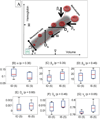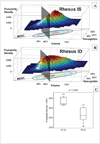Developmental plasticity of red blood cell homeostasis
- PMID: 24415575
- PMCID: PMC4086753
- DOI: 10.1002/ajh.23666
Developmental plasticity of red blood cell homeostasis
Abstract
Most human physiologic set points like body temperature are tightly regulated and show little variation between healthy individuals. Red blood cell (RBC) characteristics such as hematocrit and mean cell volume are stable within individuals but can vary by 20% from one healthy person to the next. The mechanisms for the majority of this inter-individual variation are unknown and do not appear to involve common genetic variation. Here, we show that environmental conditions present during development, namely in utero iron availability, can exert long-term influence on a set point related to the RBC life cycle. In a controlled study of rhesus monkeys and a retrospective study of humans, we use a mathematical model of in vivo RBC population dynamics to show that in utero iron deficiency is associated with a lowered threshold for RBC clearance and turnover. This in utero effect is plastic, persisting at least 2 years after birth and after the cessation of iron deficiency. Our study reports a rare instance of developmental plasticity in the human hematologic system and also shows how mathematical modeling can be used to identify cellular mechanisms involved in the adaptive control of homeostatic set points.
Copyright © 2014 Wiley Periodicals, Inc.
Conflict of interest statement
The authors have no conflicts of interest.
Figures




Similar articles
-
Elliptocytes and tailed poikilocytes correlate with severity of iron-deficiency anemia.Am J Clin Pathol. 1999 May;111(5):672-5. doi: 10.1093/ajcp/111.5.672. Am J Clin Pathol. 1999. PMID: 10230358
-
Value of red cell distribution width (RDW) and RBC indices in the detection of iron deficiency anemia.Mymensingh Med J. 2013 Apr;22(2):370-6. Mymensingh Med J. 2013. PMID: 23715364
-
Role of red cell distribution width (RDW) in the detection of iron deficiency anaemia in pregnancy within the first 20 weeks of gestation.Bangladesh Med Res Counc Bull. 2011 Dec;37(3):102-5. doi: 10.3329/bmrcb.v37i3.9122. Bangladesh Med Res Counc Bull. 2011. PMID: 22352230
-
[Iron-deficiency anemia in pregnancy].Rev Med Liege. 1994 Aug 1;49(8):436-45. Rev Med Liege. 1994. PMID: 7939012 Review. French. No abstract available.
-
Iron deficiency: assessment during pregnancy and its importance in pregnant adolescents.Am J Clin Nutr. 1994 Feb;59(2 Suppl):502S-508S discussion 508S-510S. doi: 10.1093/ajcn/59.2.502S. Am J Clin Nutr. 1994. PMID: 8304288 Review.
Cited by
-
Association of Red Blood Cell Distribution Width With Mortality Risk in Hospitalized Adults With SARS-CoV-2 Infection.JAMA Netw Open. 2020 Sep 1;3(9):e2022058. doi: 10.1001/jamanetworkopen.2020.22058. JAMA Netw Open. 2020. PMID: 32965501 Free PMC article.
-
Red blood cell population dynamics.Clin Lab Med. 2015 Mar;35(1):43-57. doi: 10.1016/j.cll.2014.10.002. Epub 2014 Dec 18. Clin Lab Med. 2015. PMID: 25676371 Free PMC article. Review.
-
Mechanistic modeling of hemoglobin glycation and red blood cell kinetics enables personalized diabetes monitoring.Sci Transl Med. 2016 Oct 5;8(359):359ra130. doi: 10.1126/scitranslmed.aaf9304. Sci Transl Med. 2016. PMID: 27708063 Free PMC article.
-
In vivo volume and hemoglobin dynamics of human red blood cells.PLoS Comput Biol. 2014 Oct 9;10(10):e1003839. doi: 10.1371/journal.pcbi.1003839. eCollection 2014 Oct. PLoS Comput Biol. 2014. PMID: 25299941 Free PMC article.
-
Rapid and reversible optical switching of cell membrane area by an amphiphilic azobenzene.Nat Commun. 2023 Jun 23;14(1):3760. doi: 10.1038/s41467-023-39032-0. Nat Commun. 2023. PMID: 37353493 Free PMC article.
References
-
- Gluckman PD, Hanson MA. Living with the past: Evolution, development, and patterns of disease. Science. 2004;305:1733–1736. - PubMed
-
- Hales CN, Barker DJP. The thrifty phenotype hypothesis. Br Med Bull. 2001;60:5–20. - PubMed
-
- Reinold C, Dalenius K, Smith B, et al. Prenancy Nutrition Surveillance 2007 Report. Atlanta: U. S. Department of Health and Human Services, Centers for Disease Control and Prevention; 2009.
-
- Allen LH. Anemia and iron deficiency: effects on pregnancy outcome. Am J Clin Nutr. 2000;71:1280S–1284S. - PubMed
Publication types
MeSH terms
Grants and funding
LinkOut - more resources
Full Text Sources
Other Literature Sources
